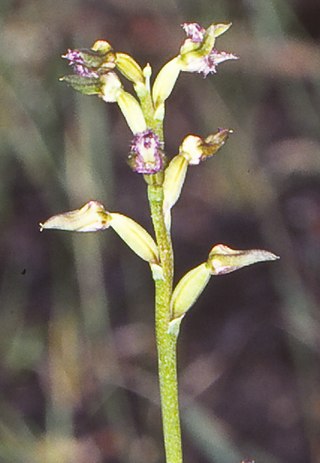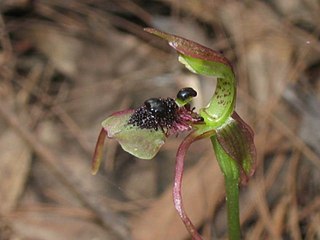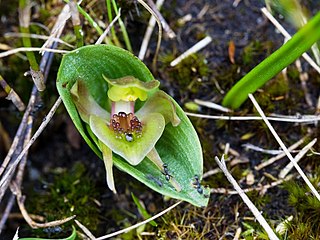
Genoplesium apostasioides, commonly known as the freak midge orchid, is a small terrestrial orchid endemic to New South Wales. It has a single thin leaf fused to the flowering stem and up to fifteen small, yellowish green flowers with a reddish labellum. The flowers do not open widely and are self-pollinating. It grows in heath and shallow moss gardens on rock ledges from the Blue Mountains to Nerriga.

Chiloglottis anaticeps, commonly known as the duck's-head wasp orchid or bird orchid is a species of orchid endemic to the New England Tableland of New South Wales. It has two narrow leaves and a single greenish brown or reddish flower with a shiny, dark green callus occupying most of the top of the labellum. One end of the callus looks like a tiny duck's head.

Chiloglottis cornuta, commonly known as the green bird orchid, is a species of orchid found in south-eastern Australia and in New Zealand, including many of its offshore islands. It has two broad leaves and a single green or pinkish flower with six to eight rounded, flattened green, reddish or blackish calli on the labellum.

Chiloglottis diphylla, commonly known as the common wasp orchid, is a species of orchid endemic to Australia. It has two broad leaves and a single narrow, greenish brown to reddish flower with a black, insect-like callus covering the upper surface of the labellum.

Chiloglottis formicifera, commonly known as the common ant orchid, is a species of orchid endemic to New South Wales. It has two broad leaves and a single narrow, greenish or reddish flower with a black, ant-like callus covering most of the upper surface of the labellum. There is a single record of this species from New Zealand.

Chiloglottis jeanesii, commonly known as the mountain bird orchid, is a species of orchid endemic to Victoria. It has two broad leaves and a single green to dark purplish brown flower with shiny black, column-like calli on the labellum.
Chiloglottis longiclavata, commonly known as the northern wasp orchid, is a species of orchid endemic to Queensland. It has two leaves and a single narrow, pinkish green flower with a dark blackish red callus covering most of the upper surface of the labellum.

Chiloglottis palachila, commonly known as the spade-lipped wasp orchid, is a species of orchid endemic to some of the higher places in northern New South Wales. It has two leaves and a single green to greenish pink flower with a black, ant-like callus on the base of the labellum. The tips of the lateral sepals have distinctive swollen, brown glandular tips.
Chiloglottis × pescottiana, commonly known as the bronze bird orchid, is a species of orchid endemic to south-eastern Australia. It has two broad leaves and a single greenish bronze or purplish brown flower with a black, ant-like callus on the labellum. It is a natural hybrid formed from a cross between Chiloglottis valida and C. trapeziformis.

Chiloglottis platyptera, commonly known as the winged ant orchid or Barrington Tops ant orchid, is a species of orchid endemic to the New England Tableland of New South Wales. It has two broad leaves and a single greenish brown flower with a callus of many glands covering most of the top of the labellum.
Chiloglottis pluricallata, commonly known as the clustered bird orchid, is a species of orchid endemic to the New England Tableland and Barrington Tops in New South Wales. It has two broad leaves and a single reddish to purplish brown flower with a callus of about six pairs of reddish to blackish glands covering two-thirds of the top of the labellum.

Chiloglottis reflexa, commonly known as the short-clubbed wasp orchid, is a species of orchid endemic to the south-eastern Australia. It has two broad leaves and a single greenish-bronze or purplish flower with an ant-like callus covering most of the top of the labellum.

Chiloglottis seminuda, commonly known as the turtle orchid, is a species of orchid endemic to south-eastern New South Wales. It has two broad leaves and a single green or reddish pink flower with a shiny black insect-like callus covering two-thirds of the base of the labellum but with the tip of the labellum free of callus.

Chiloglottis sphaerula is a species of orchid endemic to a small part of New South Wales. It has two dark green leaves and a single green to reddish pink flower with a shiny black insect-like callus covering two-thirds of the base of the labellum but with the tip of the labellum free of callus.
Chiloglottis sphyrnoides, commonly known as the forest wasp orchid, is a species of orchid endemic to north-eastern New South Wales and south-eastern Queensland. It has two dark green leaves and a single green or reddish pink flower with a shiny black, insect-like callus surrounded by red club-shaped calli on two-thirds of the base of the labellum.

Chiloglottis sylvestris, commonly known as the small wasp orchid, is a small, delicate species of orchid endemic to eastern Australia. It has two dark green leaves and a single greenish pink flower with a reddish black, insect-like callus surrounded by fine, radiating, red, club-shaped calli on two-thirds of the base of the labellum.

Chiloglottis trilabra, commonly known as the long-clubbed wasp orchid, is a species of orchid endemic to south-eastern Australia. It has two dark green leaves and a single greenish brown or pinkish flower with a dark red to black, ant-like callus covering most of the upper surface of the labellum. It is similar to both C. seminuda and C. reflexa.
Chiloglottis trullata, commonly known as the triangular ant orchid, is a species of orchid endemic to Queensland, Australia. It has two dark green leaves and a single small, green or pinkish flower with a shiny, dark reddish black, insect-like callus surrounded by reddish club-shaped calli covering most of the upper surface of the labellum.

Chiloglottis turfosa, commonly known as the bog bird orchid, is a species of orchid endemic to southern New South Wales and the Australian Capital Territory. It has two dark green leaves and a single greenish to reddish brown flower with a shiny dark reddish callus of mostly thin, column-like glands on the labellum.

Chiloglottis valida, commonly known as the large bird orchid or common bird orchid, is a species of orchid endemic to south-eastern Australia.It has two dark green leaves and a single greenish purple to purplish brown flower with six to ten blackish, column-like calli on the labellum.














